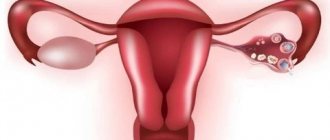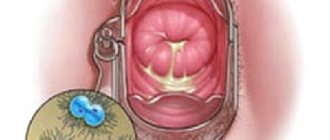Although pregnancy tests and ultrasounds are the only ways to accurately determine pregnancy, there are a number of signs and symptoms to look out for. The first signs of pregnancy include not only a missed period, but may also include fatigue, sensitivity to smells, and morning sickness. It is worth remembering that all of these are POSSIBLE signs of pregnancy, they can appear in both pregnant and non-pregnant women and are associated with ovulation and menstruation.
What are the first signs of pregnancy?
Unprotected intercourse leads to pregnancy in 40% of cases, but determining whether conception occurred during the first few weeks is quite difficult. Even a pregnancy test will not always be able to clarify the situation, because it must be carried out starting from a missed period. The only way to find out if you are pregnant with a 100% probability is to visit a doctor, but, unfortunately, it is not always possible to make an appointment with a doctor on the same day.
The first signs of pregnancy can make themselves felt almost immediately after conception, and in order not to suffer from the unknown, you just need to listen to your body. True, in most women these signs appear only at the end of the first month of pregnancy, and may not make themselves felt at all. It is possible to reliably find out whether you are pregnant only after implantation of the embryo and the beginning of a large-scale restructuring of the female body. A woman’s hormonal background changes significantly: in order for pregnancy to pass without complications, the entire body must prepare for intensive work for nine months.
A gestational dominant, or pregnancy dominant, occurs. Simply put, this is a program embedded in the nervous system in order to maintain the vital activity of the embryo, and then the fetus. The gestational dominant is formed immediately after implantation of the embryo into the uterine mucosa due to constant nerve impulses. This phenomenon serves as the beginning of changes in the life of the expectant mother, manifesting itself in several signs that are often found in the early stages of pregnancy.
Pregnancy test
Experts recommend performing a pregnancy test 14 days after fertilization. This time is enough for the amount of hCG in the body to increase. In order for testing to be most effective, it must be performed three times. If the test is done too early, there is a risk of getting a false negative result. This will cause psycho-emotional stress, which will negatively affect the condition of the female body. A negative result during a pregnancy test can occur in the following cases:
- the embryo failed to attach to the endometrium;
- taking hormonal medications that can distort test data;
- defective test.
The most reliable test to confirm pregnancy is a blood test to determine the level of hCG 2 weeks after fertilization.
Taste preferences change.
A woman may have an aversion to food that she used to love. Another option is also possible: a sudden craving for foods that you don’t like in taste or smell. Loss of appetite, especially against a background of constant nausea and malaise, as well as constant hunger, are common signs of pregnancy in the early stages. The desire to try something inedible or in an unusual combination is more typical for 4-12 weeks of pregnancy, but there are cases when a woman notices this symptom already at 2-4 weeks. It is quite possible that the desire to taste chalk or eat a sausage sandwich thickly spread with orange jam is the body’s attempts to report a lack of microelements in the body. There is no need to worry ahead of time: carrying a child requires a large amount of resources, so the body tries to prepare in time and collect reserves “for two.”
What is the 1st obstetric week of pregnancy
“The first week of pregnancy, the so-called embryonic period, is calculated from the actual conception,” clarifies obstetrician-gynecologist Maria Prokhorova. - But not everyone knows this date. Even if you have seriously prepared for conception, fertilization itself does not always occur on the day we have planned. Therefore, obstetricians-gynecologists are guided not by the actual duration of pregnancy, but by the obstetric one.”
It may differ from the actual one by about two weeks. This happens because the obstetric period is calculated not from the expected date of conception, but from the last menstrual cycle. A woman checks with a doctor on what day her last menstruation began. This date is considered the starting point in the onset of pregnancy, that is, the beginning of the first obstetric week.
The actual conception could not happen at this moment. Fertilization of an egg is possible only during the period of ovulation, when the finished cell leaves the ovary and ends up in the fallopian tube. For each woman, this happens at its own time, which depends on the characteristics of the body, hormonal status, and the duration of the menstrual cycle.
If it is short, ovulation occurs faster - before the 10th day of the cycle. If it is long, the “ovulatory window” may “open” later - from the 14th to the 18th day of the cycle. Thus, the embryonic period, which begins from the moment of conception, turns out to be one to two weeks shorter than the obstetric period.
pixabay.com/
Sudden mood swings.
You woke up in a good mood, but a minute later absolutely everything irritates you? This is not a mental disorder. Until hormonal levels stabilize, constantly changing emotions, a sudden transition from negative to positive, can accompany a woman throughout pregnancy. Explain to your loved ones that now you are more sensitive to everything that happens around you. When your hormonal levels return to normal, you will feel better. This usually happens in the second trimester of pregnancy. If emotional problems bother you too much, be sure to ask your doctor to prescribe you a mild sedative that is not contraindicated for pregnant women.
Constant fatigue and loss of strength.;
These early signs of pregnancy occur primarily as a result of the body's natural reduction in immune defenses so that the embryo can fully grow and develop. Try to reduce your stress at home and at work and distribute tasks in such a way that you do not get tired. You should not drink a lot of coffee and supplements with a high caffeine content: it depletes the body's internal resources, giving a temporary boost in strength for a short time.
Changes in sensations and perceptions
Early signs of pregnancy before a missed period are always associated with changes in certain sensations and perceptions. Almost always, already in the first days after conception, women notice an increase in breast sensitivity. Even light touches cause pain.
The mammary glands increase in size, which causes a feeling of swelling.
The skin around the nipples may also change. It darkens, and the bumps become pronounced, sometimes fluid is released from the nipple. Such symptoms indicate that the body is preparing for future breastfeeding. But such changes are not mandatory; very often the condition of the breast does not change during a long period of pregnancy.
In practice, it has been observed that after conception, women develop an aversion to certain aromas. This cannot go unnoticed, because disgust is caused by odors to which there were no previously negative reactions. Most often, the aroma of fried meat or fish seems disgusting. It is possible that in the first days of pregnancy you may experience aversion to the smell of your favorite perfume. Such symptoms may indicate the onset of early toxicosis, which will cause a lot of trouble in the near future.
A change in taste preferences may also be noted even before the delay. For example, there is a desire to eat incompatible foods or taste inedible substances. Sometimes in the first weeks of pregnancy there is a complete loss of appetite or a constant feeling of hunger.
Heaviness and nagging pain in the lower abdomen.
These symptoms of pregnancy in the early stages are observed in almost every pregnant woman and are associated with increased blood circulation in the pelvic area during the attachment of the embryo to the wall of the uterus. The heaviness is similar to premenstrual and usually does not cause serious discomfort. Severe pain can be a sign of ectopic pregnancy, miscarriage and other pathologies, so it is important to see a doctor as soon as possible. Acute pain combined with bleeding is a symptom that requires emergency medical attention.
How does fertilization occur?
Fertilization is a complex process consisting of several stages. Among them are:
- determining ovulation to increase the chance of successful fertilization;
- entry of sperm into the female genital area;
- fusion of sex gametes to form a zygote;
- movement of a fertilized egg from the fallopian tubes into the uterine cavity;
- attachment and implantation of the embryo into the endometrium.
The time during which fertilization must occur is determined by the life cycle of the gametes. The egg is capable of receiving sperm within 12-24 hours. Sperm can remain active in the body for 7 days. Therefore, determining the period of ovulation is important for successful fertilization.
Heaviness and nagging pain in the lower abdomen.
These symptoms of pregnancy in the early stages are observed in almost every pregnant woman and are associated with increased blood circulation in the pelvic area during the attachment of the embryo to the wall of the uterus. The heaviness is similar to premenstrual and usually does not cause serious discomfort. Severe pain can be a sign of ectopic pregnancy, miscarriage and other pathologies, so it is important to see a doctor as soon as possible. Acute pain combined with bleeding is a symptom that requires emergency medical attention.
Symptoms of conception during fertilization of the egg in the third and fourth weeks after fertilization
The third and fourth weeks of pregnancy are accompanied by a pronounced symptomatic picture. During this period, the embryo has successfully implanted into the wall of the uterus and begins active growth.
The main symptoms of pregnancy are:
- emotional lability;
- increase in size and the appearance of soreness of the mammary glands;
- drowsiness;
- fatigue;
- bloating;
- disruption of the gastrointestinal tract;
- libido change.
Frequent urge to urinate.
The nerve endings located in the bladder react to even the slightest impact. The growing uterus puts pressure on the bladder during pregnancy, causing a constant desire to visit the restroom. This symptom is often detected at 5-6 weeks of pregnancy after a missed period, but can appear already at the beginning of the first trimester due to individual characteristics. There is evidence that progesterone reduces the tone of the bladder, which affects its physiology.
So how to calculate ovulation?
Pregnancy begins after ovulation and fertilization of an egg by a sperm. The only thing left to do is to understand when this important event will happen. Take the calendar and look at our drawing. With its help, you can calculate the approximate date of ovulation. But remember, this is just a forecast, which is why we have drawn areas of high, medium and low probability of pregnancy around the central day.
Do not try to get pregnant exactly at the time of ovulation. It is better to cover the entire period of high probability with a “queue”. Start having sex for pregnancy 4 days before the planned date and do it every other day: 4th day before, 2nd day before, ovulation day, 2nd day after, 4th day after. This will greatly increase your chances of success.
Approximate calendar plan of the menstrual cycle. Calculations are given for cycles with a duration of 25 to 31 days.
The ideal length of the menstrual cycle is 28 days. In many articles on conception and ovulation, all discussions are built around this “textbook” case. Indeed, it is very convenient - ovulation occurs on the 14th day, dividing the cycle into two equal halves. Life is different from the ideal: the length of the cycle varies from woman to woman, but usually ranges from 25 to 31 days.
You'll likely find your case in this picture, but if your cycle is shorter or longer, there's nothing strange about it - the norm is 21 to 35 days. The following knowledge will help you calculate the day of ovulation: with a change in the length of the cycle, its first part usually decreases or increases, while the second remains unchanged and is always about two weeks. Set aside 14 days back from the planned first day of your period - get the approximate day of ovulation.
From the point of view of conception, the menstrual cycle can be divided into the following phases (shown in the figure):
- Menstruation. Sex during this period can lead to conception only under a very unusual set of circumstances. For now, relax - favorable days are ahead.
- From the end of menstruation to the 6th day before planned ovulation. The likelihood of conception at this time is minimal. Most likely, the egg not only did not leave the ovary, but was not even mature yet.
- From 5 to 3 days before the estimated date of ovulation. The likelihood of getting pregnant increases, and there are two reasons for this. Firstly, the actual day of ovulation does not always coincide with the calculated one. Secondly, sperm can wait. Most of them will die in the vagina within a couple of hours - its acidic environment fights well not only bacteria. However, those that can penetrate the uterus can live up to three, sometimes up to five days.
- Planned day of ovulation, plus or minus two days. During this period, a woman is most fertile. Considering the lifespan of the egg and sperm, sex these days is highly likely to lead to pregnancy. Of course, if there are no factors that can prevent this.
- 3 to 4 days after the estimated date of ovulation. The likelihood of getting pregnant decreases, but still remains. You remember that calculating the day of ovulation is not a very exact science? So anything is possible.
- From the 5th day after planned ovulation until the end of the cycle. Don't seriously expect to be able to conceive these days, have sex just for fun. If you tried to get pregnant during your fertile days, you may have already conceived!
How should you feel after ovulation?
During the menstrual cycle, there is only one period during which a woman feels changes occurring in her body. This is menstruation itself, and you are very familiar with the sensations from it. All other phases of the cycle are asymptomatic.
The answer to the question of how to understand that ovulation was successful is prosaic: not at all. A woman’s body simply does not have a mechanism that would inform the brain about this. So, if you woke up with the confidence that today is that very day, it’s just a game of the mind, which frolicked in a dream with the thought you desired about the joy of motherhood. Although, coincidences also happen 
When will signs of pregnancy appear after ovulation and conception?
Reliable - not yet. A regular pregnancy test will show the two coveted lines only after a delay, a test with increased sensitivity or laboratory analysis - 3-4 days earlier. Final confirmation via ultrasound will have to wait another couple of weeks.
Don't wait for pregnancy symptoms immediately after ovulation. While the fertilized egg slowly travels from the fallopian tube to its destination, almost no changes occur in the body. The first signs of pregnancy will appear only 6–10 days after ovulation, when the embryo attaches to the wall of the uterus. And they will be almost invisible:
- Change in basal temperature. If you have been measuring your basal temperature all this time, you will notice a slight drop in the graph, and then a rise to a new, higher level.
- Implantation bleeding. During the process of attachment of the embryo to the wall of the uterus, the endometrium, its inner mucous membrane, is damaged. In this case, the expectant mother may notice slight bleeding.
- Pain or cramping in the lower abdomen. Mild pain may occur along with the bleeding. Therefore, women often attribute these first signs of pregnancy to early menstruation.
Why did conception not occur after ovulation?
You tried to get pregnant, but your next period started right on time. Why did this happen? Only your doctor can answer this question for sure, but we will list some likely causes.
- Anovulatory cycle. Some menstrual cycles occur without ovulation, and this is completely normal. They are called anovulatory and are needed by the body so that it can take a little rest from constant preparation for pregnancy. During the year, a woman experiences 1–2 anovulatory cycles.
- Gynecological diseases. Sometimes conception does not occur after ovulation because a woman has gynecological diseases. Inflammation of the ovaries, obstruction of the fallopian tubes and some other conditions can significantly reduce the likelihood of pregnancy, and under certain conditions, even make conception impossible. A gynecologist can identify such diseases and prescribe treatment.
- Immune or autoimmune reactions. Sperm are very unusual cells. They contain only half the chromosome set, and from the point of view of the immune system they look like mutants. Everything is so bad that nature even had to collect them in special cooled bags and hang them outside the man’s body. In some cases, a woman’s immune mechanisms can deal with sperm as they pass through the cervix. Autoimmune reactions also occur when a man’s body destroys them. If the doctor believes that this may be the reason for unsuccessful attempts to conceive, he will prescribe tests for both the expectant mother and the expectant father.
- Low sperm quality. After sexual intercourse, sperm have to overcome a champion's obstacle course - survive in the aggressive environment of the vagina, break through the cervical mucus in the cervix, get to the desired fallopian tube, and destroy the protection of the egg. If the future dad's sperm are not very active, they may drop out before conception. To exclude this cause, it is necessary to do a spermogram.
When conception occurs after ovulation, future parents take it for granted. If pregnancy does not occur, they often begin to panic and think with horror that they will never hear the ringing laughter of children and the light steps of tiny feet in their home. Drive away unconstructive thoughts - many couples were not able to conceive the first time. Try again next month. We believe that you will definitely succeed!
Dizziness, fainting.
Brief loss of consciousness is usually associated with pressure changes. Even if a woman has never lost consciousness before, she should be especially careful. If you feel dizzy, you should provide access to fresh air: ask those nearby to open the window and ventilate the room. To avoid fainting, try to choose loose clothing made from natural materials that is appropriate for the weather. If your job involves physical labor, then you should consider reducing your workload during the day.
Period of egg fertilization
The period of fertilization of the egg is determined by the period of its viability. After the mature oocyte leaves the follicle, the germ cell retains the ability to fertilize for 12-24 hours. During this time, the sperm must penetrate the egg. If this does not happen, the oocyte completes its life cycle. The next opportunity to conceive will come in a month.
Breast sensitivity increases.
Even a slight touch to the mammary glands can cause pain; some women experience colostrum discharge from the nipples. Later, the breasts swell, enlarge, and the nipples darken. These are some of the signs that pregnancy manifests itself in the early stages. You may notice chest tenderness when moving or playing sports. Try wearing loose underwear that doesn't restrict movement. It is worth stopping active physical activity for a while, replacing it with yoga and stretching. Give preference to clothes made from soft materials that do not cause you discomfort.
Indirect symptoms
This group of pregnancy signs is subjective. They do not always indicate successful conception. Indirect symptoms include:
- decreased appetite;
- change in taste habits;
- nausea and occasional vomiting;
- increased sensitivity to various odors;
- emotional lability;
- weakness, increased fatigue;
- drowsiness;
- frequent urge to urinate;
- the appearance of pain and an increase in the size of the mammary glands;
- increase in abdominal size;
- the appearance of pigmentation in the nipple area.
The above symptoms may appear during the premenstrual period or during ovulation. A reliable sign of pregnancy is a blood test for hCG.
Heartburn.
The appearance of heartburn in the early stages is also explained by changes in hormonal levels. This symptom can occur at the very beginning of pregnancy and does not disappear until childbirth. A feeling of discomfort or burning behind the sternum is provoked by the reflux of acidic stomach contents and usually does not indicate a serious pathology. Drinking chocolate, strong tea and coffee, as well as citrus fruits increases heartburn attacks. You may want to avoid these foods at least during the first trimester of pregnancy. Wearing tight and uncomfortable clothing can also cause heartburn. It is worth monitoring your diet more carefully and avoiding long periods of time between meals.
Increase in basal temperature.
The indicator measured rectally varies depending on the woman’s hormonal background. Basal temperature can indirectly determine both ovulation and pregnancy. In the early stages, the rectal temperature rises, and pregnancy is indicated by the fact that there is no decrease in the value after a few days, as with normal cyclic changes. If this is not your first attempt to find the happiness of motherhood, then you most likely know the rules for measuring basal temperature: the correct value is the one obtained immediately after a night's sleep, without getting out of bed. Stress can affect your test results, so it's a good idea to calm down or take a medication approved by your healthcare provider before going to bed.
How does fertilization occur?
A sufficient amount of time passes from the moment of fusion of germ cells until the formation of an embryo. Experts distinguish several stages of fertilization.
Moment of fertilization
After completion of sexual intercourse, a sufficient number of sperm enters the woman’s body. Not all of them enter the uterine cavity. Many are retained by cervical mucus from the cervix.
- Sperm that have passed the barrier penetrates the area of the fallopian tubes. There, an egg awaits them, ready for fertilization.
- Thanks to a special secretion contained in the female genital tract, the acrosomal membrane is weakened. This allows the sperm to penetrate the egg.
- In order to destroy the protective membrane of the oocyte, sperm secrete the enzyme hyaluronidase.
- After all barriers are destroyed, gamete fusion occurs.
Zygote formation and further division
The fertilization process takes some time. After the sperm enters the egg, its active division occurs. When the oocyte reaches the required size, a zygote is formed. It contains genetic material received from both parents. The sex of the unborn child is determined by the chromosomal makeup of the sperm. If it contains only X chromosomes, it will be a girl. If there is a Y chromosome, then a boy will be born. The zygote moves from the fallopian tube into the uterine cavity for further attachment to the endometrium. Throughout its movement, the fertilized egg continues to divide. The final stage of this process is the blastocyst.
Blastula implantation
The blastula's job is to produce hCG, which facilitates the successful implantation of the embryo into the endometrium. At the moment when the blastula is ready to attach to the wall of the uterus, it develops into the state of a fertilized egg. After implantation, the embryo begins to feed on substances coming from the mother's bloodstream. As pregnancy progresses, the placenta develops. She begins to produce large amounts of hCG. A few days after implantation, the first clinical symptoms of pregnancy appear.
Toxicosis.
Toxicosis of pregnant women usually appears at 4 or 5 weeks after conception, but nausea and vomiting can begin to bother the expectant mother as early as the first month. Nausea is usually accompanied by weakness, lack of appetite, and headache. These symptoms during pregnancy cause a lot of trouble for the expectant mother, especially if vomiting is repeated and interferes with daily activities. Antiemetics that are not contraindicated for pregnant women are available today at any pharmacy, but you should consult a doctor before using them.
Tests and ultrasound
There is still a long way to go before pregnancy registration. However, if you are planning to conceive, then you should undergo simple research before doing so. This will help to diagnose possible complications in a timely manner and minimize risks during pregnancy.
One of the most important tests is a test for sexually transmitted infections. Many of them are asymptomatic, but significantly affect the ability to conceive and the development of the fetus in the future. To understand whether the body is ready for the 9-month test, you also need to pass:
- general blood and urine tests;
- gynecological smear;
- test for blood group and Rh factor;
- tests for HIV, hepatitis and syphilis;
- do an ultrasound of the uterus and ovaries.
If you have any chronic diseases, especially endocrine or cardiovascular diseases, consult with a specialized specialist regarding the possibility of pregnancy and how it will affect the course of your pathology.
The appearance of acne.
This symptom is also associated with hormonal changes in the body. Acne can appear even in women who have never suffered from it before. Acne during pregnancy usually disappears when hormonal levels stabilize and no longer bothers the woman. You can often miss this phenomenon, mistaking it for a component of premenstrual syndrome, especially if you have previously been treated for acne. Topical, and especially systemic, retinoids can adversely affect fetal development, so you should stop using these medications if there is a delay.
Increased abdominal volume.
To bear a child, not only the mother’s internal resources are required, but also reliable protection. The layer of subcutaneous fat in the abdomen is necessary to maintain the optimal temperature of the internal organs. Weight gain in this area is a feature of the female body that has existed since ancient times, which allows, in case of hunger, to use reserves as an energy substrate to support the life of the expectant mother and baby. Eating “for two” is not an option in this case: it is worth distinguishing between emotional and physical hunger. Excessive weight gain is harmful to the baby and complicates the course of pregnancy, and is also a risk factor for gestational diabetes.
And yet, the main symptom, the appearance of which may mean pregnancy, is a delay in the onset of menstruation for more than three days
. Obstetrics classifies it as probable signs, and the above symptoms are only speculative. From the very first days of the delay, the presence of pregnancy is confirmed with fairly high accuracy using special tests that respond to an increase in the content of hCG (human chorionic gonadotropin) in the urine. These are various test strips that are convenient to use at home. There are several rules that reduce the likelihood of false positive and false negative results:
- It is worth using morning urine, since the hCG content in it is higher.
- It is not recommended to increase the amount of fluid consumed before the test. Urine diluted with water has a lower concentration of the hormone and is not informative for the test.
- It is important to check the expiration date of the test. Expired tests may show incorrect results.
The most rational decision if the test result is positive is to consult a doctor in order to determine the quantitative value of hCG and undergo a transvaginal gynecological ultrasound. This procedure allows you to most accurately determine the duration of pregnancy and ensure that the embryo develops inside the uterus, excluding ectopic pregnancy.
Signs of conception by day
The first two weeks after fertilization are characterized by active changes in the body. The embryo goes a long way from attachment to the endometrium to the beginning of the formation of internal organs. Let's look at the main symptoms of successful egg fertilization by day.
First day
The sperm travels through the fallopian tube to the egg. After this, the gametes merge to form a zygote. This period is not accompanied by any clinical symptoms.
The third day
It is characterized by the body’s readiness for embryo implantation, which is accompanied by hormonal changes. In this regard, a feeling of nausea, fatigue, headache, and loss of appetite appear.
Fourth day
After the sex cells have fused to form a zygote, it moves into the uterine cavity. During this period, abdominal discomfort, a feeling of fullness, and increased gas formation may appear.
Fifth day
On the fifth day, the embryo is implanted into the wall of the uterus. The process takes several days. If the embryo remains in the fallopian tube, an ectopic pregnancy develops. This is accompanied by an increase in body temperature, chills, sweating, and pale skin.
Sixth day
If there is pregnancy, on the 6th day there is an increase in basal temperature. The woman feels discomfort in the lower abdomen. The symptoms are similar to those of menstruation.
Seventh day
Embryo implantation may be accompanied by the appearance of bloody discharge from the genitals. They are meager in nature and go away on their own.
Eighth day
Hormonal imbalance leads to severe fatigue, drowsiness, fatigue, headaches and dizziness.
Ninth day
This period is characterized by the presence of a small amount of bleeding and signs of hormonal changes.
Tenth day
In a normal pregnancy, the process of embryo implantation is completed on the 10th day. This can be confirmed by a blood test for gonadotropin hormone.
Eleventh day
As a rule, PMS symptoms appear on the 11th day of the menstrual cycle. These include emotional lability, headache, sensitivity of the mammary glands and an increase in their size. If these signs are absent, then most likely the pregnancy is developing successfully.
Twelfth day
Dyspeptic symptoms are added to the clinical signs. These include vomiting, increased sensitivity to smells, feelings of nausea, and changes in taste habits.
Thirteenth day
Hormonal changes lead to pronounced changes in the mammary glands. They increase in size and become painful on palpation. In some cases, slight discharge from the nipples is allowed.
Sixteenth day
This period is characterized by the formation of the nervous and skeletal system of the fetus.










